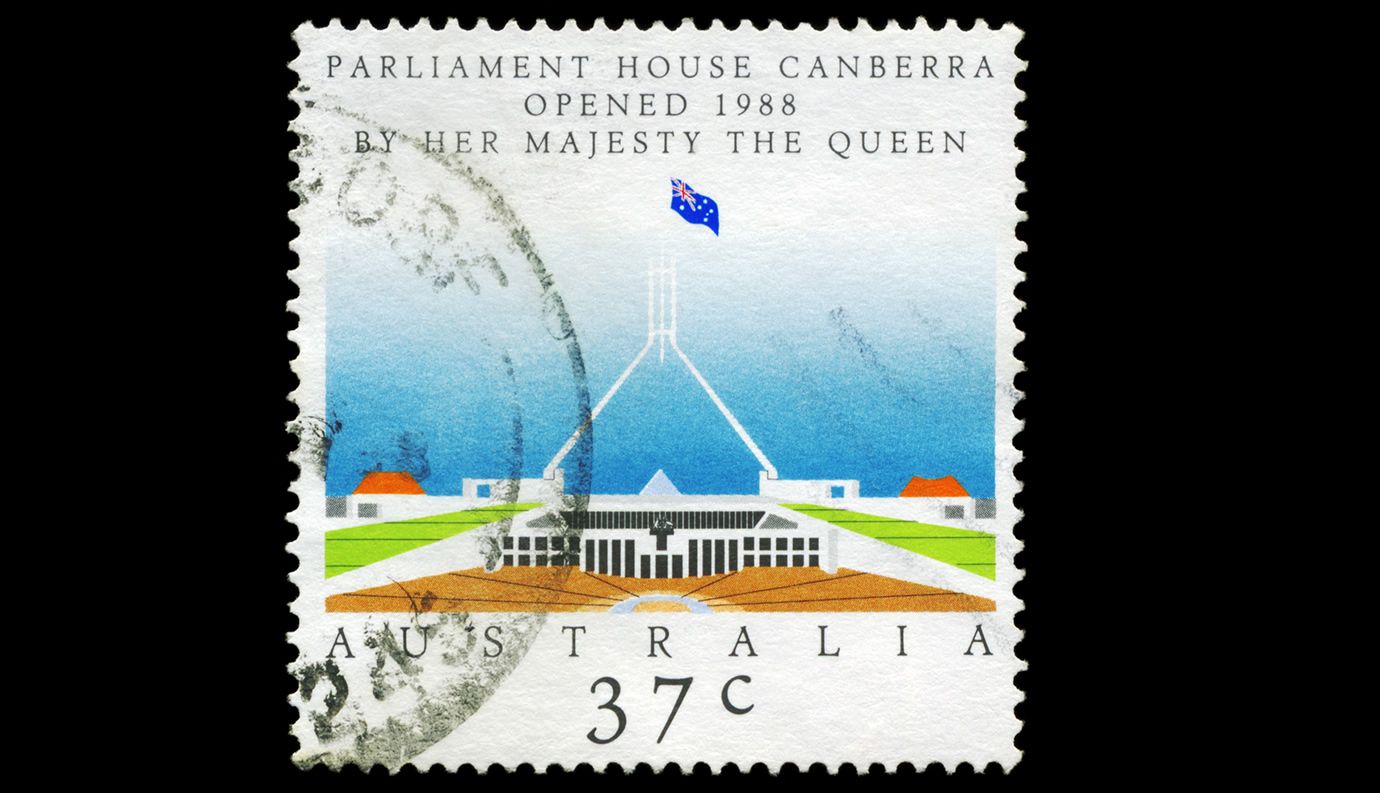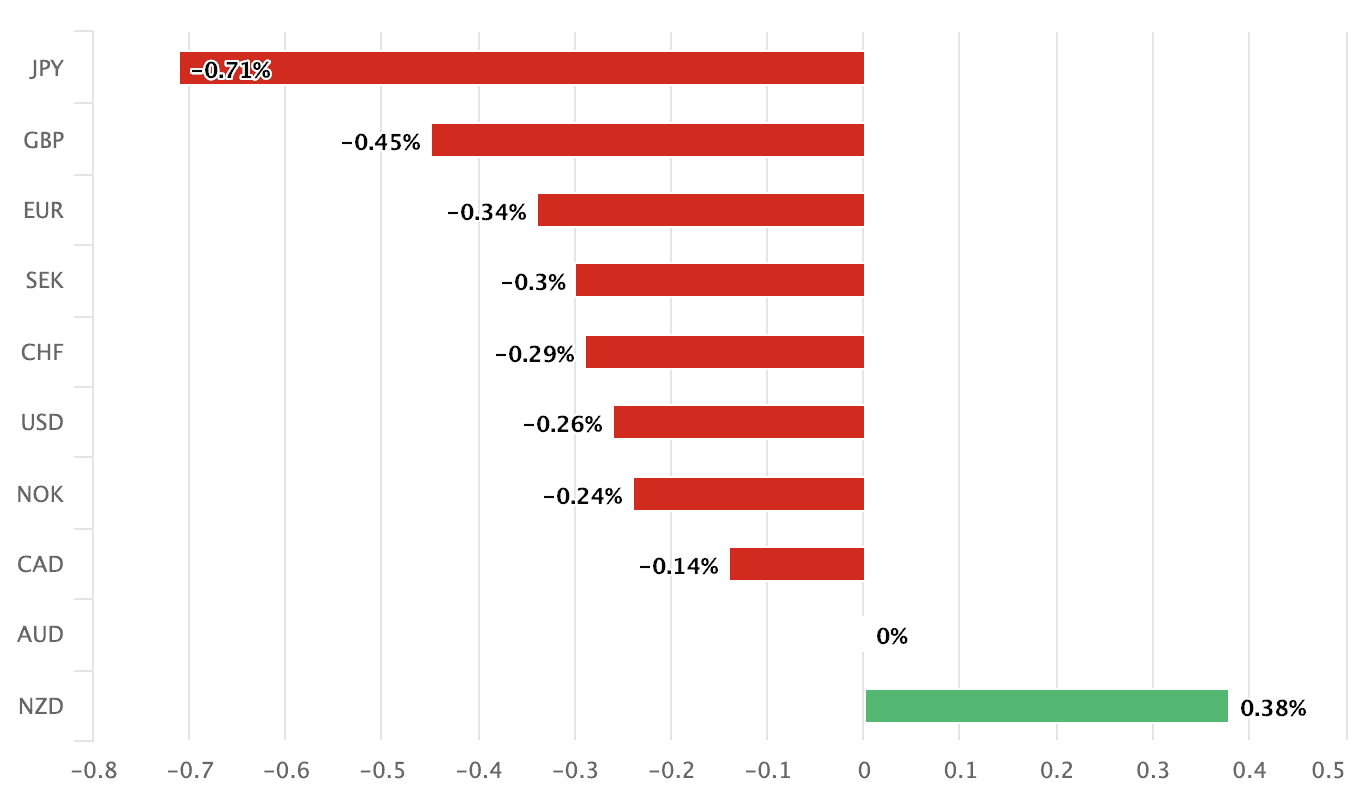Australian Dollar on Sale as Global Markets Sink but Employment Data Stems the Losses
- Written by: James Skinner
-

© AlexanderZam, Adobe Stock
- AUD on sale alongside global stocks after Fed decision, housing spook.
- AUD sees solid jobs growth in November, higher unemployment rate.
- Repeal of interest-only cap seen as "an act of desparation" by APRA.
The Australian Dollar was a notable underperformer Thursday after solid labour market statistics proved unable to arrest a decline sparked by the ongoing concerns about the housing and global financial markets.
The Aussie is a proxy for global investor sentiment so when markets are falling, as they are Thursday, the Antipodean currency inevitably suffers.
"The combinationof higher UST yields relative to Australian and NZ government bond yields as well as risk-off trading has weighed heavily on the Antipodean currencies," says Manuel Oliveri, strategist with Crédit Agricole.
Australia's Dollar is lower against all G10 currencies, save for the New Zealand Dollar, which is also weighed down by poor sentiment stemming from the Federal Reserve's decision to raise interest rates again overnight.
The Aussie Dollar is outperforming its Kiwi counterpart courtesy of some better-than-expected labour market statistics. "While the AUD has some support from neutral Australian labour market data and AUD/NZD buying, the NZD has had no such fortune following week NZ GDP data. We remain short AUD/USD," says Oliveri.
Employment data out of Australia today came in ahead of expectations, with the economy creating 37K new jobs in November when currency markets had looked for just 20K.
Above: The AUD is struggling on Thursday, December 20.
The participation rate nudged higher to 65.7%, up from the 65.6% reported in the October report.
"It suggests there is limited room for the participation rate to move any higher from here," says Best Deda, Chief Economist with St. George Bank in Sydney.
The unemployment rate did however nudge higher with a reading of 5.1% disappointing against expectations for 5.0%.
Victoria was the stand out state in the report having created 30.9k net new jobs in November, which is the strongest of any State or territory. It was also the biggest monthly jobs rise in Victoria in two years.
"We continue to expect national jobs growth to continue and for slack to gradually be worked out of the labour market. However, we would not be surprised to see some moderation in 2019," says Deda.
The Australian labour market has been a relative bright spot for the economy in 2018, with jobs growth averaging 22,000 for the year-to-date and 23,500 over the six months to November.
Currency markets care about the labour data because faster wage growth means greater demand within an economy and higher inflation further down the line, which is important for the interest rate outlook.
Changes in rates are only normally made in response to movements in inflation but impact currencies because of the push and pull influence they have on capital flows and their allure for short-term speculators.
"More full‑time jobs growth is bound to lead to a lower underemployment rate and support a pick‑up in wages growth. Australia’s favourable employment backdrop is one of the reasons we continue to expect the RBA to begin raising the policy interest rate in November 2019," says Joseph Capurso with Commonwealth Bank of Australia.
The Reserve Bank of Australia (RBA) has held its cash rate at a record low of 1.5% for more than two years now, citing below-target inflation and wage growth that is insufficient to support a sustainable return of the consumer price index to the upper end of the 2%-to-3% target band.
RBA rate policy has been a significant driver behind the Aussie's 2018 losses, although not the only driver, and Thursday's labour data is unlikely to be enough to cause markets to immediately reappraise their expectations for rates.
As a result, any boost the Aussie recieves following the data may fade quickly, particularly if concerns over stability of the housing market and global factors continue to dictate market sentiment toward the Antipodean currency.
Advertisement
Bank-beating GBP/AUD exchange rates. Get up to 5% more foreign exchange by using a specialist provider to get closer to the real market rate and avoid the gaping spreads charged by your bank when providing currency. Learn more here
Labour Stats Ease House Price Concerns
The strong labour market statistics might go some way in quelling concerns over the stability of Australia's housing market, according to one analyst.
"A strong labour market report, with the unemployment rate remaining at 5% (as expected), should temporarily help temper some of the downside associated with Australia's softening house prices," says Joseph Capurso, a currency strategist at Commonwealth Bank of Australia.
But not everybody is in agreement because some say recent events in the housing market could eventually cause the Australian economy to slide into recession.
"We have strong concerns for Australia’s housing market triggering the first Australian recession in a generation, but for now, AUD only a bit weak in the crosses. Regulators easing up on mortgage lending standards on interest only mortgages looks like rank desperation," says John Hardy, chief FX strategist at Saxo Bank.
The Australian Prudential Regulation Authority (APRA) said Wednesday that it will scrap 21-month old restrictions that sought to prevent banks from filling their loan books with interest-only mortgages.
Those mortgages are popular because they enable amateur landlords and investors to carry out transactions while risking only a limited amount of their own capital, if they risk any at all.
"The ceiling has been in place since March 2017 and was intended to be temporary. This is the second time this year APRA eased some of its policy measures to mitigate the risks associated with certain forms of housing lending. In April 2018, APRA removed its 10%/yr speed limit on the growth in lending for residential investment properties," says CBA's Capurso.
Interest only mortgages contributed to years of runaway price growth in the housing market and came to be viewed by regulators as a financial stability risk, given the threat posed to banks with large exposures to those types of loans.
But house prices are in the midst of a correction lower, which has stemmed transaction activity and is also posing another threat to the economy.
Above: Source: Australian Bureau of Statistics.
Falling prices mean negative equity for some borrowers and a 'negative wealth effect' that could ultimately see households defer spending.
Above: Source: Australian Bureau of Statistics.
"This reversal benefits investors as they are incentivised to use this loan type for ease of tax deductibility (and no financial incentive to pay off the loan)," says Annette Beacher, chief Asia Pacific macro strategist at TD Securities.
The RBA flagged in December, slowing demand and falling activity in the housing market as something it is watching.
It also took note of slowing loan growth, which is a symptom of falling demand, tighter regulations and recent increases in mortgage rates that were the result of higher international funding costs.
The APRA's decision to remove the interest-only lending cap may simply have been a natural response to the intervention seemingly having done its job in slowing the growth of risky mortgage issuance.
But it could also be viewed as an act of desperation by authorities that might now be becoming more concerned about the odds of a more serious downturn being in the pipeline.
Federal Reserve Policy Matters for Australia
Thursday's price action comes in the wake of December's Federal Reserve interest rate statement and in response to escalating concerns over the stability of the Aussie housing market.
Future Fed policy is key to the outlook for the Antipodean currency given how that it, and RBA policy, have seen the gap between yields on Australian and U.S. bonds shift in favour of the greenback this year.
Advertisement
Bank-beating GBP/AUD exchange rates. Get up to 5% more foreign exchange by using a specialist provider to get closer to the real market rate and avoid the gaping spreads charged by your bank when providing currency. Learn more here

